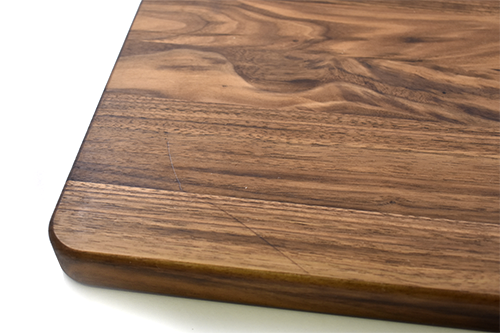
While hardwood is the best choice for you cutting boards out of bamboo, plastic and glass, they do require a bit more love and care than the rest. With that being said, if you maintain your cutting board, it could last you a lifetime. Here is a simple guide on how you can take care of your cutting boards so that they will stay in your kitchen forever, no matter the amount of use.
To start off, here are a few special reminders on everyday care of your cutting board.
The best oil mixture to use, hands down, is a combination of beeswax and mineral oil. Oiling your boards help condition and protect them, creating a seal to prevent knife marks and keep the boards in top shape. Warm your beeswax and mineral in a pot on the stop to form a liquid. Using a cloth, dip it in the mixture and spread it across the board. Only a little is needed. Once covered, use a dry cloth to wipe the board off and leave it to dry. Place the remaining mixture in a jar and store it for further uses.
Your cutting board should be condition at least once a month, depending on its frequency of use.
There a different ways to sanitize your board.
An all-natural method is known as the salt and lemon method. This involves sprinkling your hardwood board with coarse salt and rubbing a lemon cut in half over top. Moving in circular motions, the lemon juice and salt react as the perfect disinfectant.
Worried about germs deep down? Another great way to sterilize your board is by spreading an even coat of 3% Hydrogen Peroxide across the surface of your board. Watch it fizz as it kills any bacteria that has made its way down the cracks.
You should disinfect your cutting board at least once a month if used on a regular basis and at least once a week if your board is used to cut meat.
Got nasty stains on your board? No problem! To remove any stain on a hardwood cutting board, simply sprinkle a decent amount of baking soda across the surface of the board, focusing on the location of the stain. Dampen a sponge in hot water and use it to scrub the board, ensuring to put much attention to the spot where the stain lies. Rinse and wash your board immediately after scrubbing to remove any remaining baking soda.
This method can be done whenever a stain occurs.
Wood cutting boards tend to absorb smells, which can become problematic when garlic or onions are involved in a recipe. To remove foul odors from your boards, there are two methods.
The first method is our favorite, all-natural method mentioned above. The fighting power of salt and lemon make both a great sanitizer and deodorizer at the same time.
Another safe method to use would be by lightly coating the board with white vinegar or diluted bleach (about a spoonful of bleach per litre of water). Both of these methods will both sanitize and deodorize your cutting boards. Using a spray bottle, spritz your board with either white vinegar or diluted bleach, let sit and rinse afterwards.
This can be done whenever odors occur or once a month as a disinfecting method.
Once you’ve used your board multiple times, it starts to grow quite a collection of nasty knife marks. This can easily be fixed with a few pieces of sand paper. Simply start sanding down the top layer of a cutting board with a piece of 160 grit paper and finish it off with a 220 grit piece to get a smooth result. Ensure to oil your board after doing so to condition the raw wood and protect it from future knife marks.
This can be done whenever knife marks start to cover the entire board. Resist doing this too often, as it makes your cutting board thinner each time.
Now that you know how to care for your wood cutting boards and wood products, consider giving a lasting corporate gift or wedding favor. Order your boards wholesale and save money with our amazing wholesale pricing. Visit our selection of hardwood cutting boards and choose your favorite models and designs today!